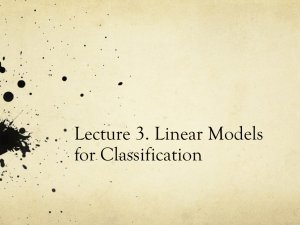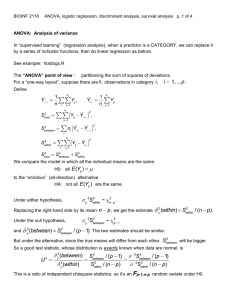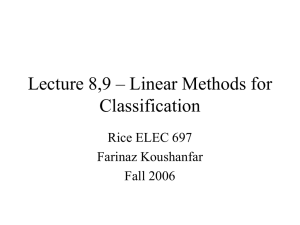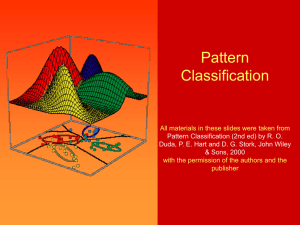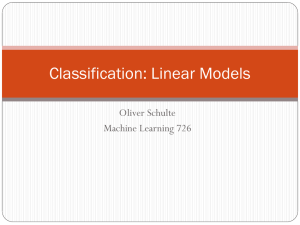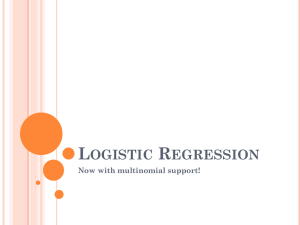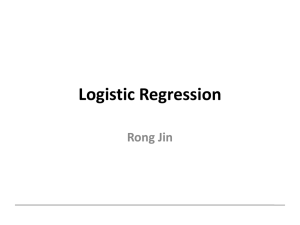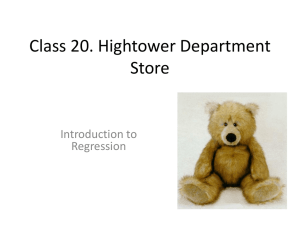Chapter 4
advertisement
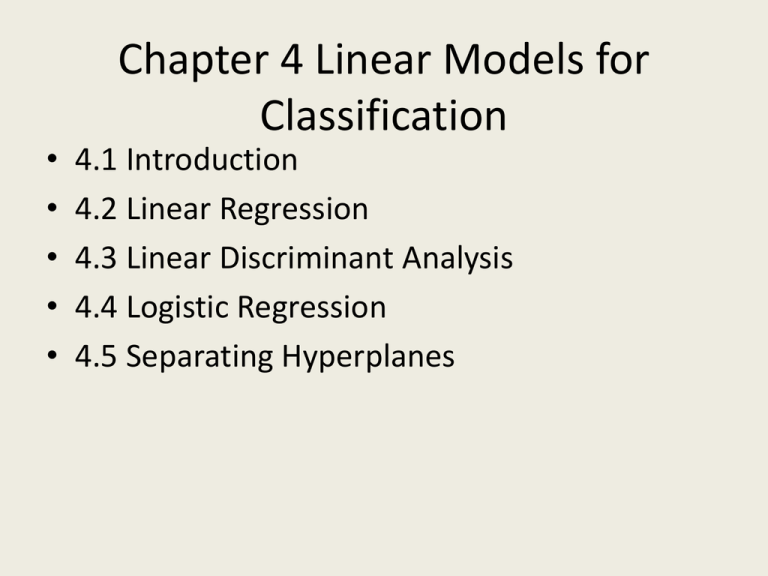
• • • • • Chapter 4 Linear Models for Classification 4.1 Introduction 4.2 Linear Regression 4.3 Linear Discriminant Analysis 4.4 Logistic Regression 4.5 Separating Hyperplanes 4.1 Introduction • The discriminant function for the kth indicator response variable • The boundary between class k and l • Linear boundary: an affine set or hyper plane 4.1 Introduction • 线性边界的条件: “Actually, all we require is that some monotone transformation of or Pr(G = k|X = x) be linear for the decision boundaries to be linear.” (?) • 推广 函数变换,投影变换…… 4.2 Linear Regression of an Indicator Matrix • Indicator response matrix • Predictor • Linear regression model 将分类问题视为回归 问题,线性判别函数 4.2 Linear Regression of an Indicator Matrix • Parameter estimation • Prediction 4.2 Linear Regression of an Indicator Matrix • 合理性(?) Rationale: an estimate of conditional probability (?) 线性函数无界(Does this matter?) 4.2 Linear Regression of an Indicator Matrix • 合理性(?) Masking problem 4.3 Linear Discriminant Analysis • 应用多元统计分析:判别分析 • Log-ratio: Prior probability distribution • Assumption: each class density as multivariate Gaussian 4.3 Linear Discriminant Analysis (LDA) • Additional assumption: classes have a common covariance matrix Log-ratio: 可以看出,类别之间的边界关于x是线性函数 4.3 Linear Discriminant Analysis (LDA) • Linear discriminant function • Estimation • Prediction G(x) = 4.3 Linear Discriminant Analysis (QDA) • covariance matrices are not assumed to be equal, we then get quadratic discriminant functions(QDA) • The decision boundary between each pair of classes k and l is described by a quadratic equation. 4.3.1 Regularized Discriminant Analysis • A compromise between LDA and QDA • In practice α can be chosen based on the performance of the model on validation data, or by cross-validation. 4.3.2 Computations for LDA • Computations are simplified by diagonalizing or • Eigen-decomposition 4.3.3 Reduced rank Linear Discriminant Analysis • 应用多元统计分析:fisher判别 • 数据降维与基本思想: “Find the linear combination such that the between class variance is maximized relative to the within-class variance.” W is the within-class covariance matrix, and B stands for the between-class covariance matrix. 4.3.3 Reduced rank Linear Discriminant Analysis • Steps 4.4 Logistic Regression • The posterior probabilities of the K classes via linear functions in x. 4.4 Logistic Regression • 定义合理性,发生比分母选择不影响模型 • 归一化,得到后验概率 4.4.1 Fitting Logistic Regression Models • Maximum likelihood estimation log-likelihood (two-class case) • Setting its derivatives to zero 4.4.1 Fitting Logistic Regression Models • Newton-Raphson algorithm 4.4.1 Fitting Logistic Regression Models • matrix notation (two-class case) y –the vector of values X –the matrix of values p –the vector of fitted probabilities with ith element W –the NN diagonal matrix of weights with ith diagonal element 4.4.1 Fitting Logistic Regression Models • matrix notation (two-class case) 4.4.2 Example: South African Heart Disease • 实际应用中,还要关心模型(预测变量) 选择的问题 • Z scores--coefficients divided by their standard errors • 大样本定理 则 的MLE 近似服从(多维)标准正态分布, 且 4.4.3 Quadratic Approximations and Inference • Logistic回归的性质 4.4.4 L1 Regularized Logistic Regression • penalty • Algorithm -- nonlinear programming methods(?) • Path algorithms -- piecewise smooth rather than linear 4.4.5 Logistic Regression or LDA? • Comparison (不同在哪里?) Logistic Regression VS LDA 4.4.5 Logistic Regression or LDA? “The difference lies in the way the linear coefficients are estimated.” Different assumptions lead to different methods. • LDA– Modification of MLE(maximizing the full likelihood) • Logistic regression – maximizing the conditional likelihood 4.5 Separating Hyperplanes • To construct linear decision boundaries that separate the data into different classes as well as possible. • Perceptrons-- Classifiers that compute a linear combination of the input features and return the sign. (Only effective in two-class case?) • Properties of linear algebra (omitted) 4.5.1 Rosenblatt's Perceptron Learning Algorithm • Perceptron learning algorithm Minimize 表示被错分类的样品组成的集合 • Stochastic gradient descent method is the learning rate 4.5.1 Rosenblatt's Perceptron Learning Algorithm • Convergence If the classes are linearly separable, the algorithm converges to a separating hyperplane in a finite number of steps. • Problems 4.5.2 Optimal Separating Hyperplanes • Optimal separating hyperplane maximize the distance to the closest point from either class By doing some calculation, the criterion can be rewritten as 4.5.2 Optimal Separating Hyperplanes • The Lagrange function • Karush-Kuhn-Tucker (KKT)conditions • 怎么解? 4.5.2 Optimal Separating Hyperplanes • Support points 由此可得 事实上,参数估计值只由几个支撑点决定 4.5.2 Optimal Separating Hyperplanes • Some discussion Separating Hyperplane vs LDA Separating Hyperplane vs Logistic Regression When the data are not separable, there will be no feasible solution to this problemSVM 谢谢大家 !
